Production of Low-Cost, High-Strength Concrete with Waste Glass as Fine Aggregates Replacement
Abstract
1. Introduction
2. Methods
2.1. Mix Design
2.2. Mixing and Casting Procedure
2.3. Testing
3. Results and Discussion
3.1. Slump Flow
3.2. Density
3.3. Compressive Strength
3.4. Ultrasonic Pulse Velocity (UPV)
3.5. Modulus of Elasticity
3.6. Split Tensile Strength
3.7. Flexure Strength
3.8. Economic Study
4. Conclusions
- In terms of density, results showed a slight decrease as the percentage of WGS increased in concrete. The density was decreased by 5% for the specimen with a 75% replacement level compared to the control specimen. Other studies reached the same conclusion regarding the density due to the lighter weight of WGS compared to QS. However, for other types of WGS where the weight of WGS is higher than the replaced sand, the density showed to slightly increase with the increase of replacement level.
- Regarding concrete workability, slump flow results showed a slight increase in the distribution diameter as the replacement percentage of WGS increased, which indicates better workability. Specimen WGS75 showed the best workability among the concrete mixes, which is similar to the findings of other studies that adopted the same replacement level. However, in other studies, it was shown that the shape of glass particles (the presence of sharp edges) could have an adverse effect on workability.
- In terms of material stiffness, results showed that the specimen with 50% waste glass sand showed the highest elasticity modulus among all specimens. The elasticity modulus was shown to increase by 7% for specimen WGS50. However, as the replacement percentage reached 75%, the elasticity modulus showed to decrease by 15% compared to the control specimen. The authors recommend the 50% replacement level for the best material stiffness.
- In terms of compressive strength, results showed that concrete specimens with a WGS replacement level of 50% had the highest compressive strength compared to the control specimen. The compressive strength was increased by 27% for specimen WGS50 compared to specimen WGS0. This was confirmed by other similar studies, which recommended a replacement level between 20–75% for the highest compressive strength. Moreover, UPV results showed the same trend where specimen WGS50 had the highest values compared to other specimens, which indicates higher compressive strength at a 50% replacement level.
- In terms of tensile strength, both split tensile and flexure tests showed that concrete with 50% WGS had the best performance in tension. Split tensile and flexure strengths for specimen WGS50 were 9% and 50% higher than control specimens, respectively. This was confirmed by other studies, which recommended replacement levels between 25% to 75% for the highest tensile and flexure strength.
- In terms of production cost, replacing sand with WGS led to decreasing the production cost by up to 8% for a replacement percentage of 75%. As for the performance/cost (P/C) ratio, it was concluded that as the replacement level of WGS increased, the P/C ratio for compressive, tensile, and flexure strength increased, which means that using WGS as sand replacement is economically feasible. However, the authors recommend a replacement level of 50% since it led to the highest P/C ratios (37% for compressive strength, 16% for split tensile strength, and 60% for flexure strength). This will help in reducing the overall construction cost since high-strength concrete is known for its high production cost
Author Contributions
Funding
Institutional Review Board Statement
Informed Consent Statement
Conflicts of Interest
References
- Tamanna, N.; Tuladhar, R.; Sivakugan, N. Performance of recycled waste glass sand as partial replacement of sand in concrete. Constr. Build. Mater. 2020, 239, 117804. [Google Scholar] [CrossRef]
- Ashish, D.K. Feasibility of waste marble powder in concrete as partial substitution of cement and sand amalgam for sustainable growth. J. Build. Eng. 2018, 15, 236–242. [Google Scholar] [CrossRef]
- Małek, M.; Łasica, W.; Jackowski, M.; Kadela, M. Effect of waste glass addition as a replacement for fine aggregate on properties of mortar. Materials 2020, 13, 3189. [Google Scholar] [CrossRef] [PubMed]
- Meddah, M.S. Use of waste window glass as substitute of natural sand in concrete production. IOP Conf. Ser. Mater. Sci. Eng. 2019, 603, 032011. [Google Scholar] [CrossRef]
- Olofinnade, O.M.; Ede, A.N.; Ndambuki, J.M.; Ngene, B.U.; Akinwumi, I.I.; Ofuyatan, O. Strength and microstructure of eco-concrete produced using waste glass as partial and complete replacement for sand. Cogent Eng. 2018, 5, 1483860. [Google Scholar] [CrossRef]
- Kazmi, D.; Williams, D.J.; Serati, M. Waste glass in civil engineering applications—A review. Int. J. Appl. Ceram. Technol. 2020, 17, 529–554. [Google Scholar] [CrossRef]
- Harrison, E.; Berenjian, A.; Seifan, M. Recycling of waste glass as aggregate in cement-based materials. Environ. Sci. Ecotechnol. 2020, 4, 100064. [Google Scholar] [CrossRef]
- Khatib, J.; Jahami, A.; Elkordi, A.; Baalbaki, O. Structural performance of reinforced concrete beams containing plastic waste caps. Mag. Civ. Eng. 2019, 7, 73–79. [Google Scholar]
- Bawab, J.; Khatib, J.; Jahami, A.; Kenai, S.; Elkordi, A. Effect of using cathode-ray tubes (CRT) waste glass on concrete properties. BAU J.-Sci. Technol. 2020, 2, 3. [Google Scholar]
- Ferdous, W.; Manalo, A.; Siddique, R.; Mendis, P.; Zhuge, Y.; Wong, H.S.; Lokuge, W.; Aravinthan, T.; Schubel, P. Recycling of landfill wastes (tyres, plastics and glass) in construction—A review on global waste generation, performance, application and future opportunities. Resour. Conserv. Recycl. 2021, 173, 105745. [Google Scholar] [CrossRef]
- Sawant, V.G. Experimental Investigation of Waste Glass Powder as the Partial Replacement of Sand in Making Concrete. Iconic Res. Eng. J. 2018, 1, 7–9. [Google Scholar]
- Ahmad, J.; Zhou, Z.; Usanova, K.I.; Vatin, N.I.; El-Shorbagy, M.A. A Step towards Concrete with Partial Substitution of Waste Glass (WG) in Concrete: A Review. Materials 2022, 15, 2525. [Google Scholar] [CrossRef] [PubMed]
- Warnphen, H.; Supakata, N.; Kanokkantapong, V. The Reuse of Waste Glass as Aggregate Replacement for Producing Concrete Bricks as an Alternative for Waste Glass Management on Sichang Island. Eng. J. 2019, 23, 43–58. [Google Scholar] [CrossRef]
- Atoyebi, O.D.; Gana, A.J.; Longe, J.E. Strength assessment of concrete with waste glass and bankoro (Morinda Citrifolia) as partial replacement for fine and coarse aggregate. Results Eng. 2020, 6, 100124. [Google Scholar] [CrossRef]
- Tiwari, A.; Singh, S.; Nagar, R. Feasibility assessment for partial replacement of fine aggregate to attain cleaner production perspective in concrete: A review. J. Clean. Prod. 2016, 135, 490–507. [Google Scholar] [CrossRef]
- Collivignarelli, M.C.; Cillari, G.; Ricciardi, P.; Miino, M.C.; Torretta, V.; Rada, E.C.; Abbà, A. The production of sustainable concrete with the use of alternative aggregates: A review. Sustainability 2020, 12, 7903. [Google Scholar] [CrossRef]
- Wang, T.; San Nicolas, R.; Kashani, A.; Ngo, T. Sustainable utilisation of low-grade and contaminated waste glass fines as a partial sand replacement in structural concrete. Case Stud. Constr. Mater. 2022, 16, e00794. [Google Scholar] [CrossRef]
- Khatib, J.M.; Jahami, A.; Elkordi, A.; Abdelgader, H.; Sonebi, M. Structural assessment of reinforced concrete beams incorporating waste plastic straws. Environments 2020, 7, 96. [Google Scholar] [CrossRef]
- Khatib, J.; Jahami, A.; El Kordi, A.; Sonebi, M.; Malek, Z.; Elchamaa, R.; Dakkour, S. Effect of municipal solid waste incineration bottom ash (MSWI-BA) on the structural performance of reinforced concrete (RC) beams. J. Eng. Des. Technol. 2021. [Google Scholar] [CrossRef]
- Soliman, N.A.; Tagnit-Hamou, A. Partial substitution of silica fume with fine glass powder in UHPC: Filling the Micro Gap. Constr. Build. Mater. 2017, 139, 374–383. [Google Scholar] [CrossRef]
- Soliman, N.A.; Tagnit-Hamou, A. Development of ultra-high-performance concrete using glass powder—Towards ecofriendly concrete. Constr. Build. Mater. 2016, 125, 600–612. [Google Scholar] [CrossRef]
- Jiao, Y.; Zhang, Y.; Guo, M.; Zhang, L.; Ning, H.; Liu, S. Mechanical and fracture properties of ultra-high performance concrete (UHPC) containing waste glass sand as partial replacement material. J. Clean. Prod. 2020, 277, 123501. [Google Scholar] [CrossRef]
- Chu, S.H.; Li, L.; Shen, P.L.; Lu, J.X.; Poon, C.S. Recycling of waste glass powder as paste replacement in Green UHPFRC. Constr. Build. Mater. 2022, 316, 125719. [Google Scholar] [CrossRef]
- Salahaddin, S.D.; Haido, J.H.; Wardeh, G. The behavior of UHPC containing recycled glass waste in place of cementitious materials: A comprehensive review. Case Stud. Constr. Mater. 2022, 17, e01494. [Google Scholar] [CrossRef]
- Yoo, D.-Y.; You, I.; Zi, G. Effects of waste liquid–crystal display glass powder and fiber geometry on the mechanical properties of ultra-high-performance concrete. Constr. Build. Mater. 2021, 266, 120938. [Google Scholar] [CrossRef]
- Abellán-García, J. Tensile behavior of recycled-glass-UHPC under direct tensile loading. Case Stud. Constr. Mater. 2022, 17, e01308. [Google Scholar] [CrossRef]
- Kou, S.C.; Xing, F. The effect of recycled glass powder and reject fly ash on the mechanical properties of fibre-reinforced ultrahigh performance concrete. Adv. Mater. Sci. Eng. 2012, 2012, 263243. [Google Scholar] [CrossRef]
- Standard Test Method for Flow of Hydraulic Cement Mortar. Available online: https://www.astm.org/c1437-20.html (accessed on 16 October 2022).
- Standard Test Method for Static Modulus of Elasticity and Poisson’s Ratio of Concrete in Compression. Available online: https://www.astm.org/c0469_c0469m-22.html (accessed on 16 October 2022).
- Standard Test Method for Compressive Strength of Hydraulic Cement Mortars (Using 2-in. or [50-mm] Cube Specimens). Available online: https://www.astm.org/c0109_c0109m-20.html (accessed on 16 October 2022).
- Standard Test Method for Density of Hydraulic Cement. Available online: https://www.astm.org/c0188-17.html (accessed on 16 October 2022).
- Standard Test Method for Flexural Strength of Hydraulic-Cement Mortars. 2021. Available online: https://www.astm.org/c0348-21.html (accessed on 16 October 2022).
- Standard Test Method for Splitting Tensile Strength of Cylindrical Concrete Specimens. Available online: https://www.astm.org/standards/c496 (accessed on 16 October 2022).
- Standard Test Method for Pulse Velocity Through Concrete. 2016. Available online: https://www.astm.org/c0597-16.html (accessed on 16 October 2022).
- Liu, T.; Wei, H.; Zou, D.; Zhou, A.; Jian, H. Utilization of waste cathode ray tube funnel glass for ultra-high performance concrete. J. Clean. Prod. 2020, 249, 119333. [Google Scholar] [CrossRef]
- American Concrete Institute. Building Code Requirements for Structural Concrete (ACI 318-14): An ACI Standard: Commentary on Building Code Requirements for Structural Concrete (ACI 318R-14), an ACI Report; American Concrete Institute: Farmington Hills, MI, USA, 2014. [Google Scholar]


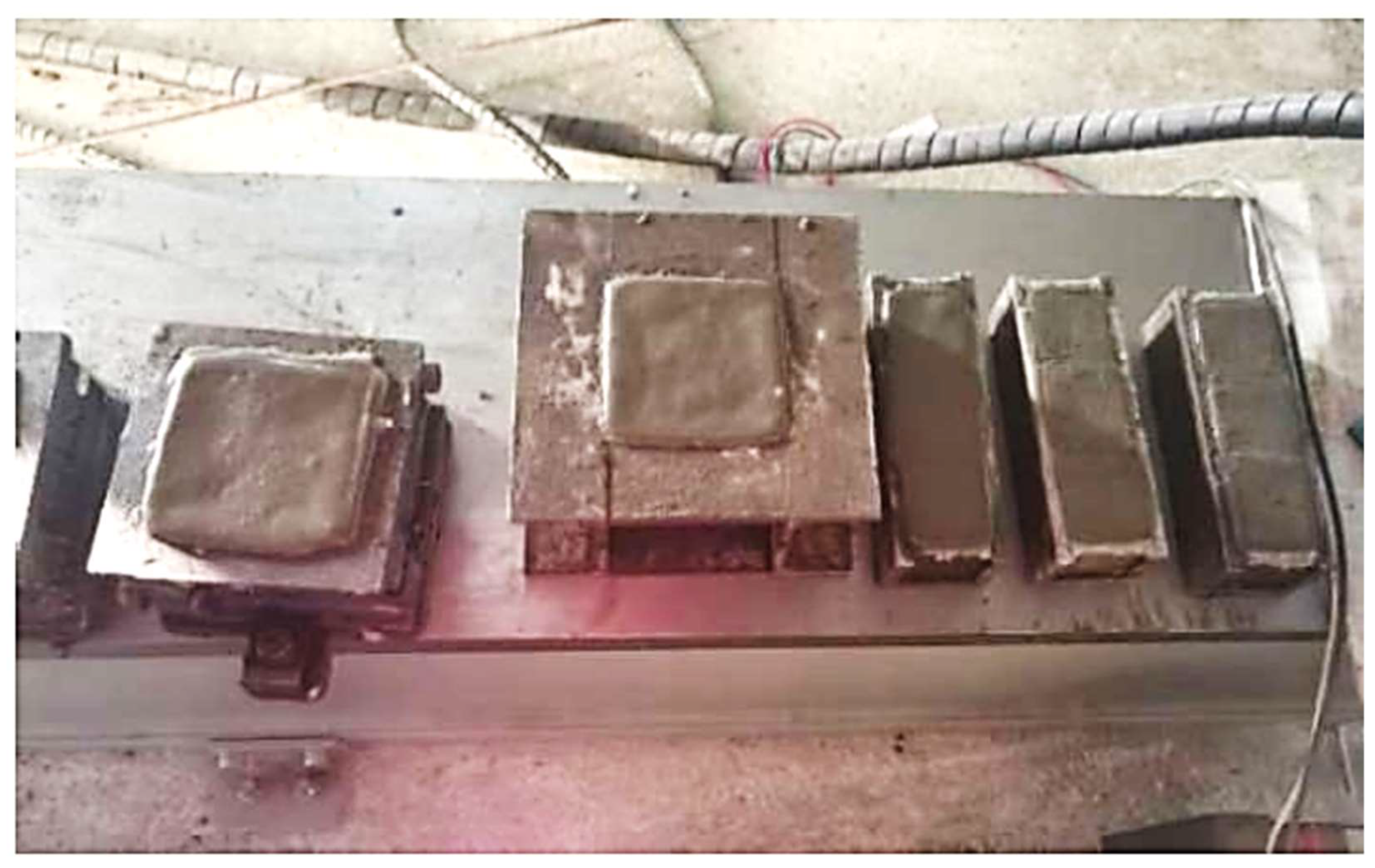



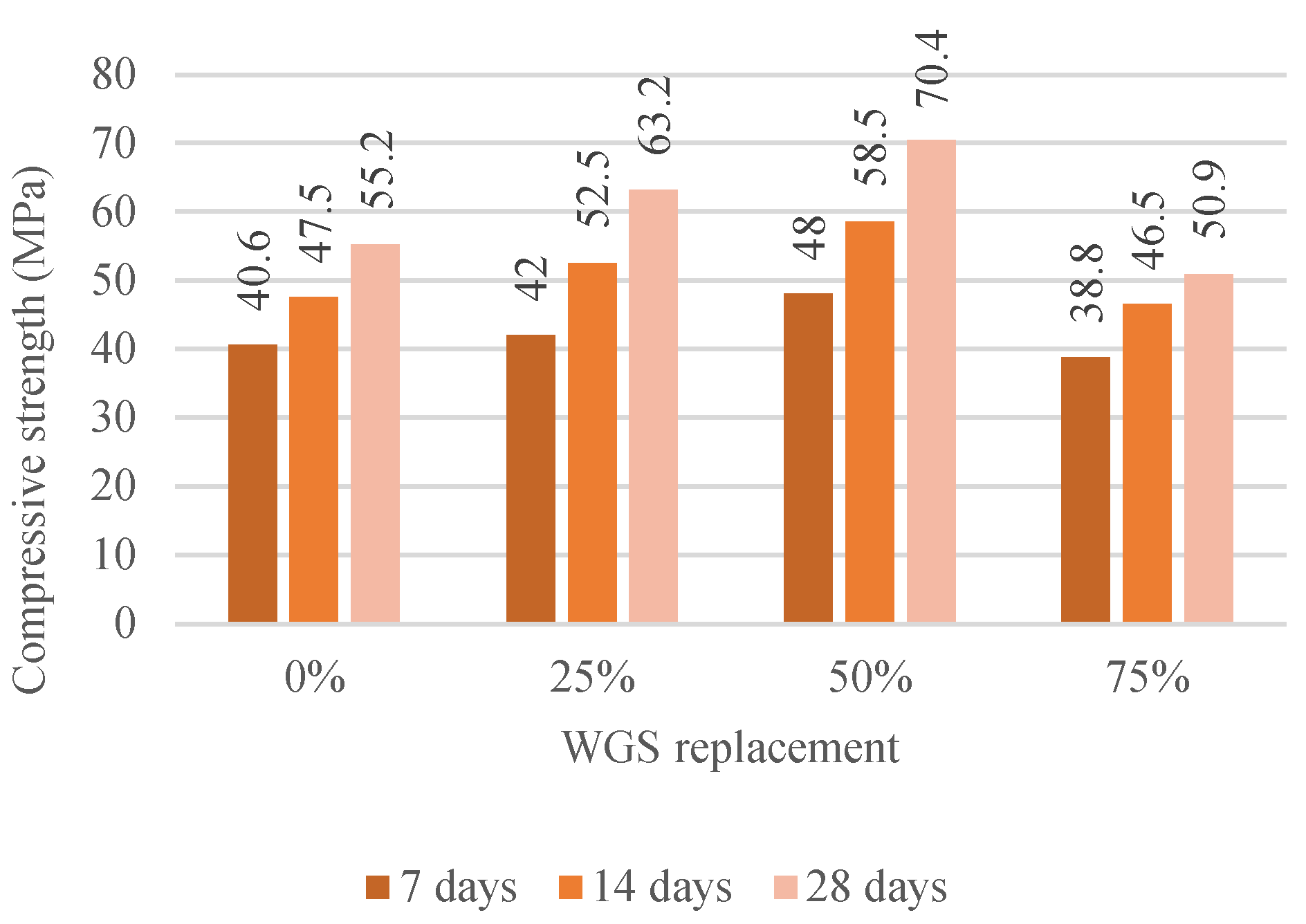
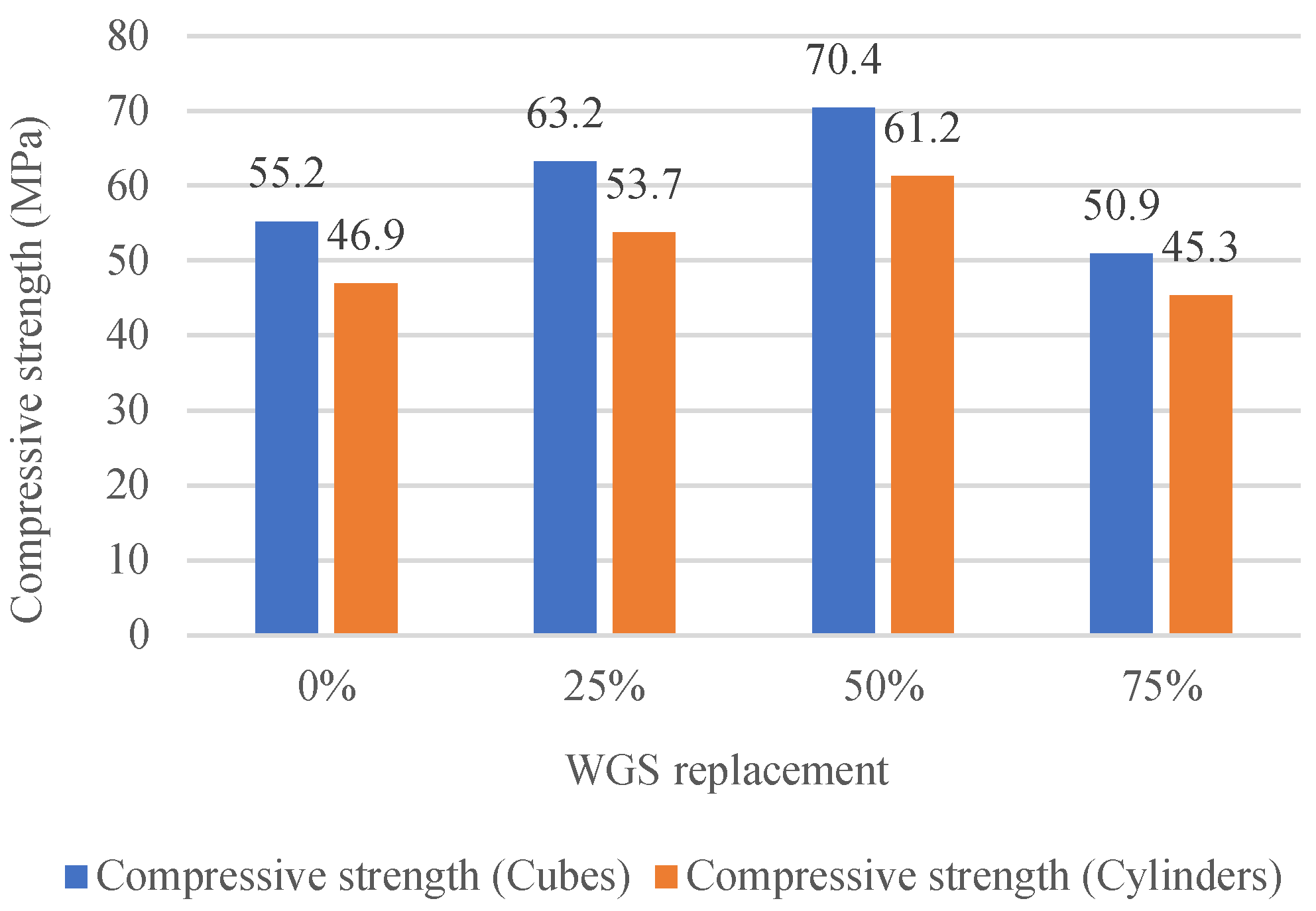

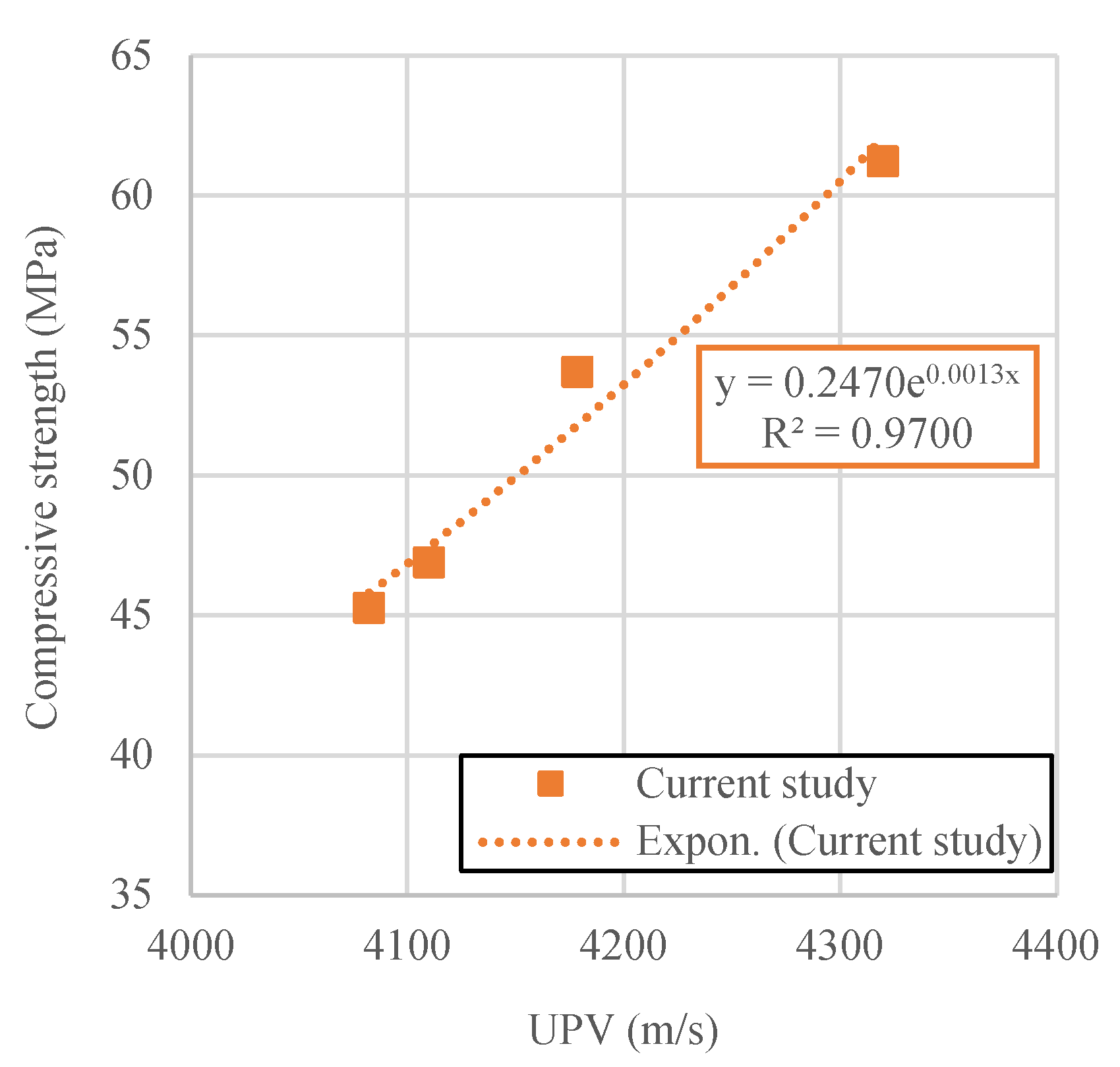
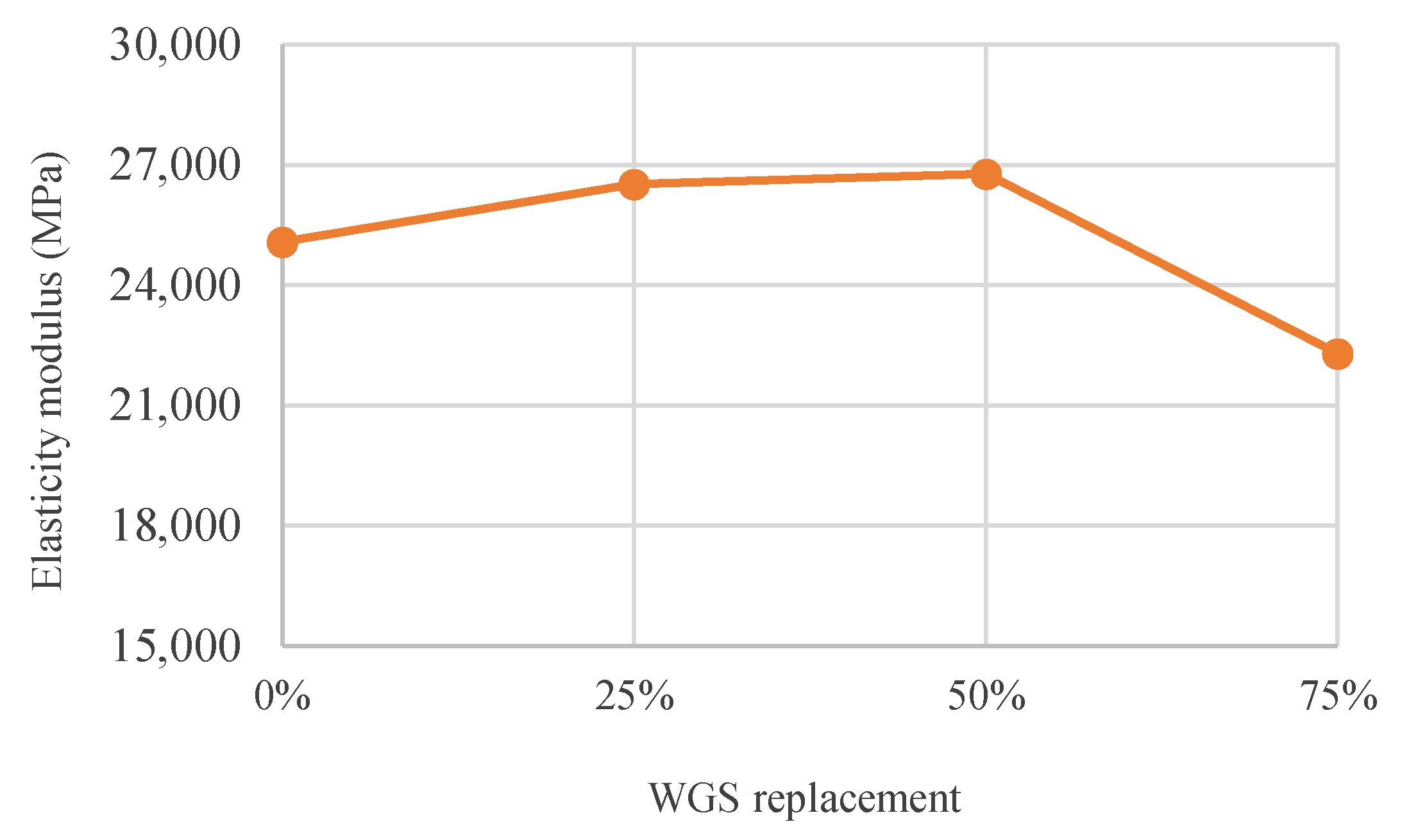
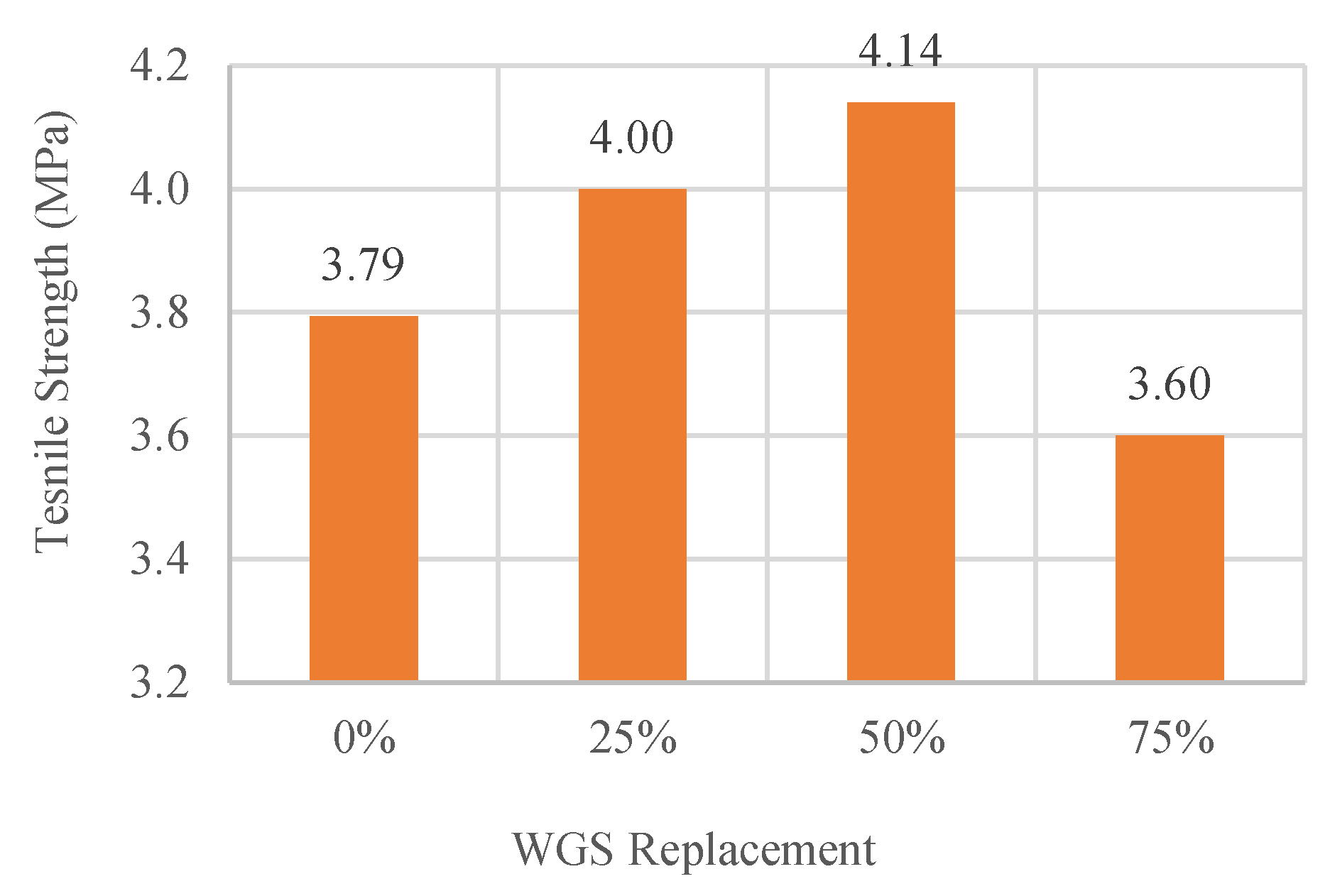
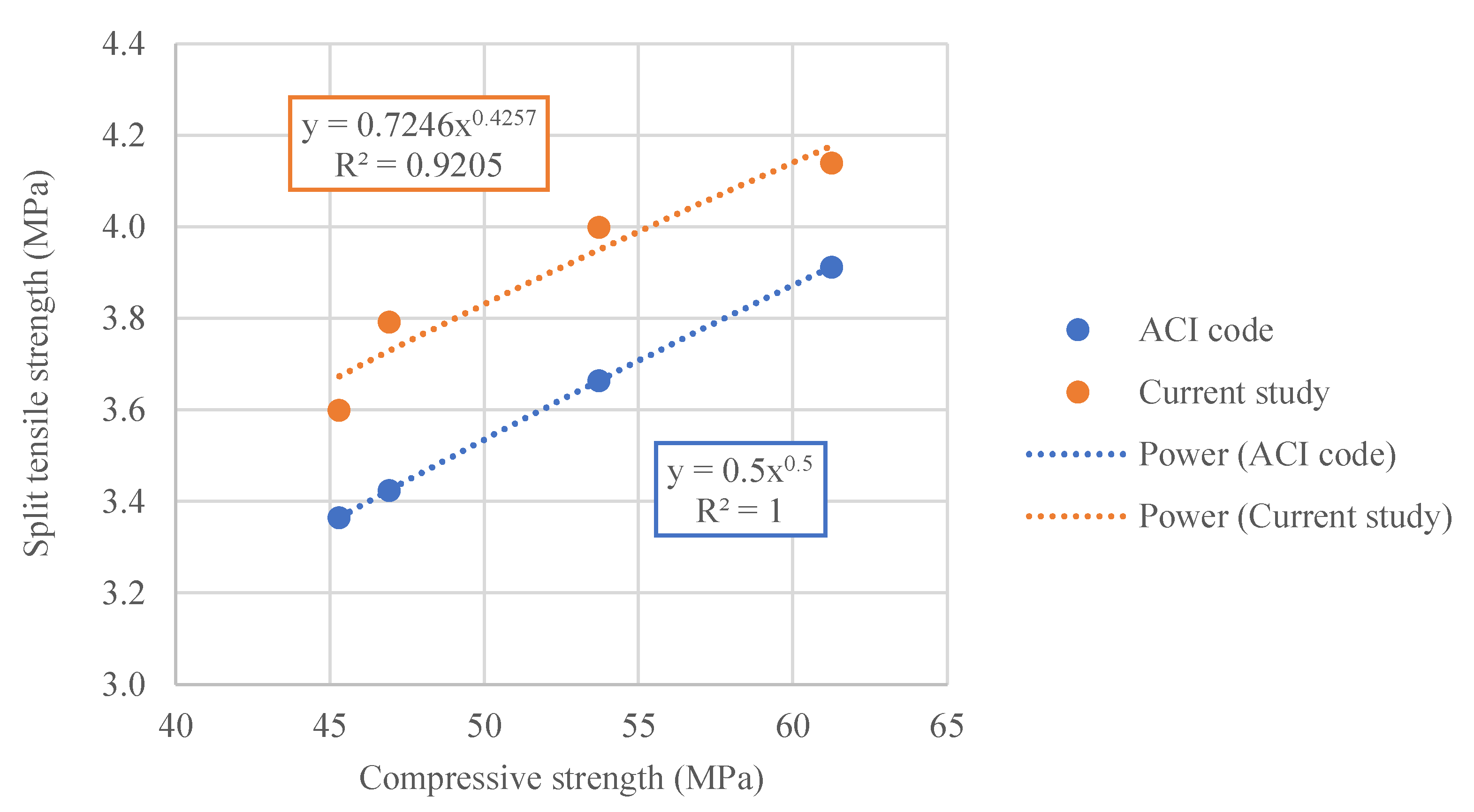


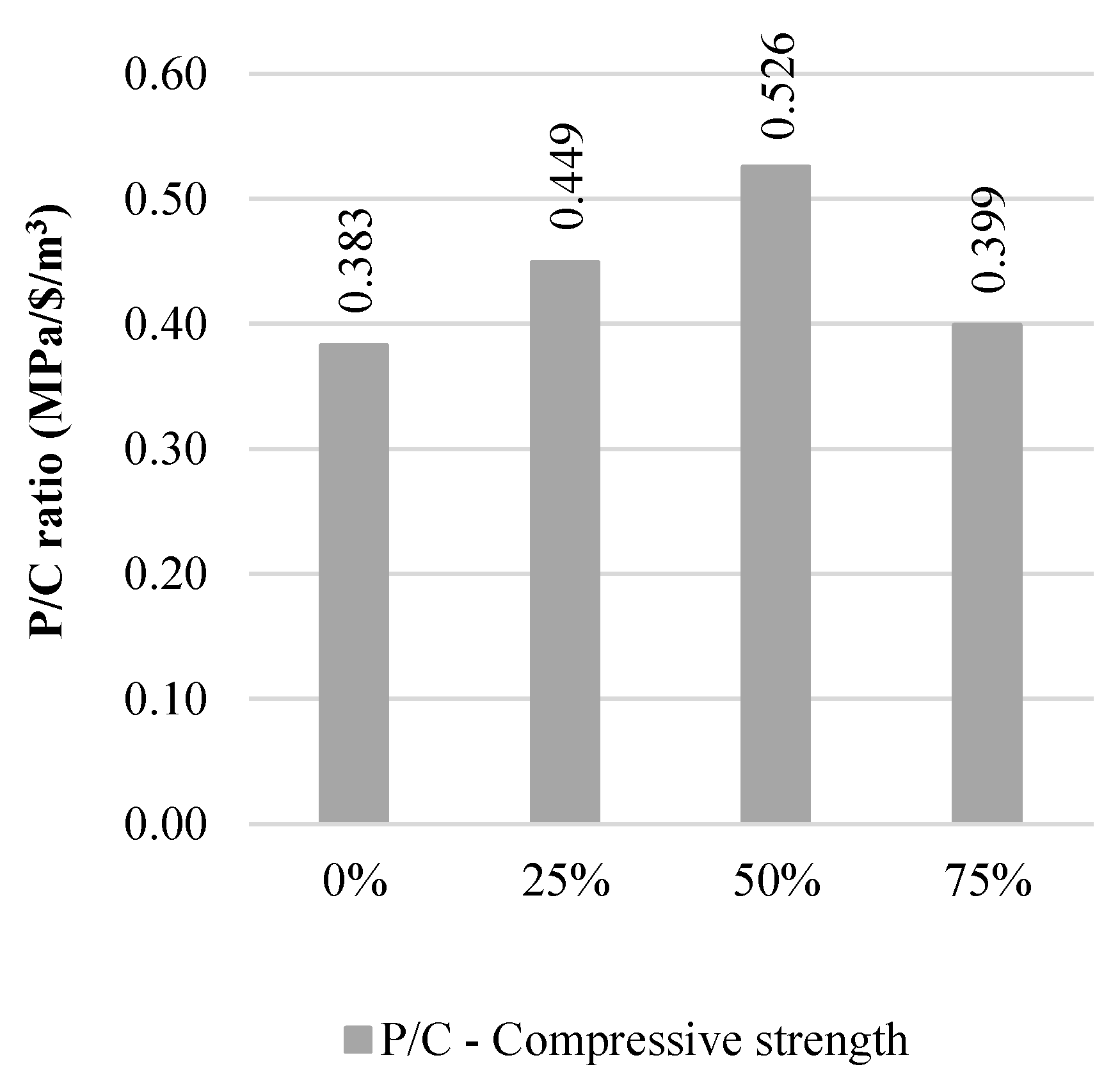
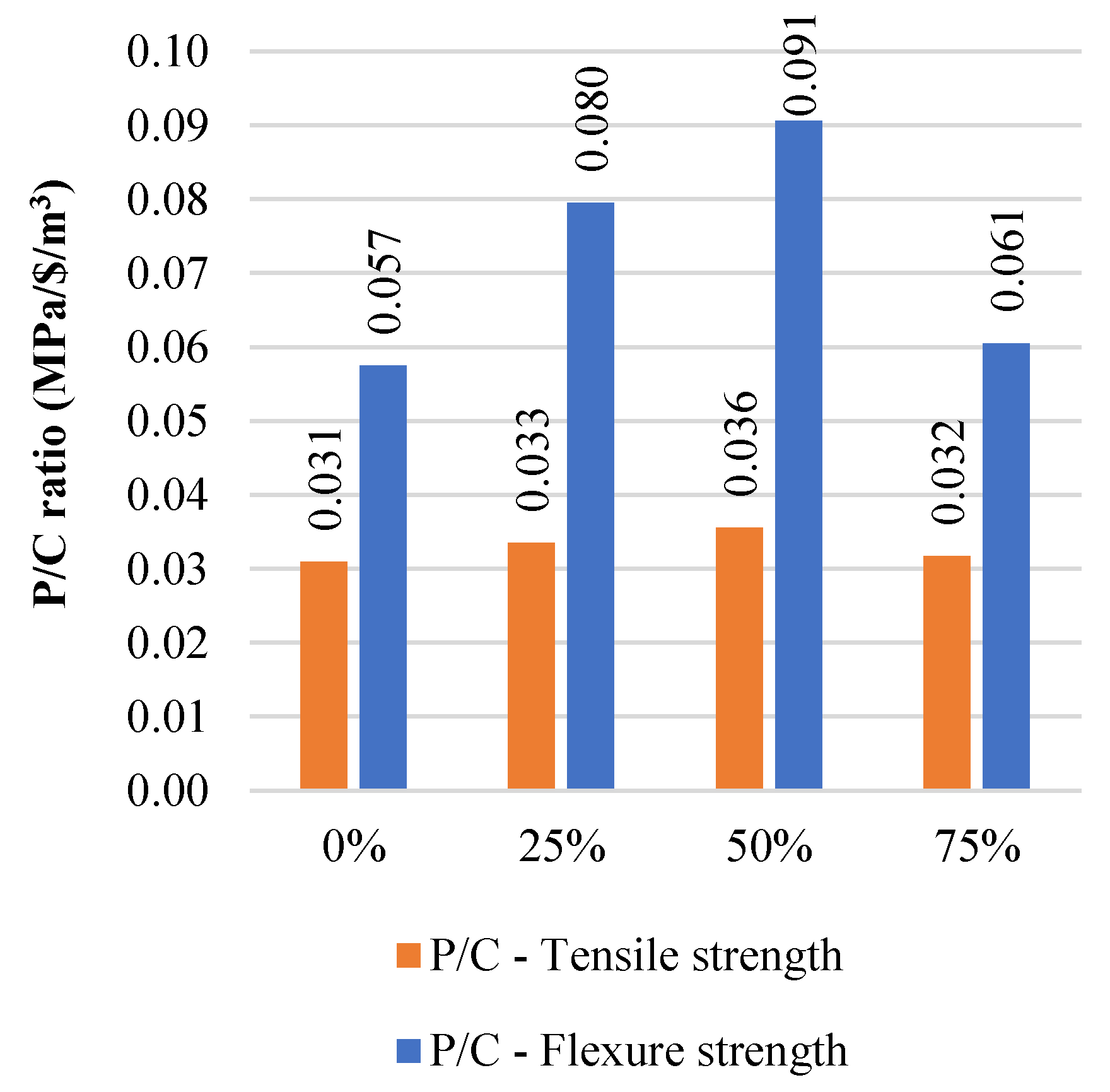
| Properties | Identification | QS | WGS | SF | QP | Cement |
|---|---|---|---|---|---|---|
| Chemical Composition (%) | Silicon Dioxide (SiO2) | 99.43 | 71.10 | 98.86 | 99.20 | 22.8 |
| Iron Oxide (Fe2O3) | 0.02 | 0.51 | 0.14 | 0.01 | 4.43 | |
| Aluminum Oxide (Al2O3) | 0.18 | 2.15 | 0.12 | 0.10 | 4.01 | |
| Calcium Oxide (CaO) | 0.11 | 11.10 | 0.57 | 0.21 | 65.32 | |
| Magnesium Oxide (MgO) | 0.01 | 1.30 | 0.20 | 0.17 | 2.07 | |
| Sodium Oxide (Na2O) | - | 14.07 | 0.35 | 0.11 | 0.07 | |
| Potassium Oxide (K2O) | 0.03 | 0.28 | 0.21 | 0,81 | 0.56 | |
| Physical Properties | Packing Density (kg/m3) | 1536.31 | 1579.62 | - | - | - |
| Mean Particle Diameter (µm) | 300 | 300 | - | - | - | |
| Max. Particle Diameter (µm) | 600 | 600 | - | - | - | |
| Crushing Values (%) | 94.72 | 96.71 | - | - | - |
| Materials (kg/m3) | WGS0 | WGS25 | WGS50 | WGS75 |
|---|---|---|---|---|
| Cement | 802 | 802 | 802 | 802 |
| SF | 223 | 223 | 223 | 223 |
| Water | 246 | 246 | 246 | 246 |
| QS | 962 | 722 | 481 | 241 |
| WGS | 0 | 241 | 481 | 722 |
| QP | 241 | 241 | 241 | 241 |
| HRWRA 1 | 30.75 | 30.75 | 30.75 | 30.75 |
| Specimen | ft 1 (MPa) | f’c 2 (MPa) | ft/f’c |
|---|---|---|---|
| WGS0 | 3.79 | 46.9 | 0.081 |
| WGS25 | 4.00 | 53.7 | 0.074 |
| WGS50 | 4.14 | 61.3 | 0.068 |
| WGS75 | 3.60 | 45.3 | 0.079 |
| Material | Cost ($/m3) | |||
|---|---|---|---|---|
| WGS0 | WGS25 | WGS50 | WGS75 | |
| Cement | 32.08 | 32.08 | 32.08 | 32.08 |
| SF | 33.45 | 33.45 | 33.45 | 33.45 |
| Water | 1.25 | 1.25 | 1.25 | 1.25 |
| QS | 20.00 | 15.00 | 10.00 | 5.00 |
| WGS | 0.00 | 2.00 | 4.00 | 6.00 |
| QP | 5.00 | 5.00 | 5.00 | 5.00 |
| HRWRA | 30.75 | 30.75 | 30.75 | 30.75 |
| ∑ | 122.53 | 119.53 | 116.53 | 113.53 |
Publisher’s Note: MDPI stays neutral with regard to jurisdictional claims in published maps and institutional affiliations. |
© 2022 by the authors. Licensee MDPI, Basel, Switzerland. This article is an open access article distributed under the terms and conditions of the Creative Commons Attribution (CC BY) license (https://creativecommons.org/licenses/by/4.0/).
Share and Cite
Jahami, A.; Khatib, J.; Raydan, R. Production of Low-Cost, High-Strength Concrete with Waste Glass as Fine Aggregates Replacement. Buildings 2022, 12, 2168. https://doi.org/10.3390/buildings12122168
Jahami A, Khatib J, Raydan R. Production of Low-Cost, High-Strength Concrete with Waste Glass as Fine Aggregates Replacement. Buildings. 2022; 12(12):2168. https://doi.org/10.3390/buildings12122168
Chicago/Turabian StyleJahami, Ali, Jamal Khatib, and Rabab Raydan. 2022. "Production of Low-Cost, High-Strength Concrete with Waste Glass as Fine Aggregates Replacement" Buildings 12, no. 12: 2168. https://doi.org/10.3390/buildings12122168
APA StyleJahami, A., Khatib, J., & Raydan, R. (2022). Production of Low-Cost, High-Strength Concrete with Waste Glass as Fine Aggregates Replacement. Buildings, 12(12), 2168. https://doi.org/10.3390/buildings12122168










